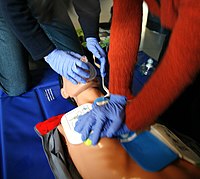
Photo from wikipedia
Background Patients who achieve a return of spontaneous circulation (ROSC) with prolonged cardiac arrest have been recognized to have a poor prognosis. This might lead to reluctance in the provision… Click to show full abstract
Background Patients who achieve a return of spontaneous circulation (ROSC) with prolonged cardiac arrest have been recognized to have a poor prognosis. This might lead to reluctance in the provision of post-resuscitation care. Hence, we evaluated the impact of cardiac arrest time on neurologic outcomes in out-of-hospital cardiac arrest (OHCA) patients. Methods This cross-sectional study used a hospital-based nationwide registry of OHCAs in Korea between 2012 and 2016. All witnessed OHCA patients aged ≥ 15 years and treated with targeted temperature management were included. We collected the time from collapse to sustained ROSC, which was defined as the downtime. The primary outcome was a favorable neurological outcome at hospital discharge. A multiple logistic regression analysis was conducted to determine independent factors for primary outcome in patients with downtime > 30 minutes. Results Overall, neurologically favorable outcome rates were 30.5% in 1,963 patients. When the downtime was stratified into categories of 0–10, 11–20, 21–30, 31–40, 41–50, 51–60, and > 60 minutes according to 10-minute intervals, neurologically favorable outcome rates were 58.2%, 52.3%, 37.3%, 24.6%, 14.1%, 17.4%, and 16.7%, respectively (P < 0.001). In patients with downtime > 30 minutes, age 51–70 years (odds ratio [OR], 5.35; 95% confidence interval [CI], 2.50–11.49), age ≤ 50 years (OR, 13.16; 95% CI, 6.06–28.57), shockable rhythm (OR, 3.92; 95% CI, 2.71–5.68), bystander resuscitation (OR, 1.80; 95% CI, 1.27–2.55), cardiac cause (OR, 3.50; 95% CI, 1.69–7.25), percutaneous coronary intervention (OR, 1.82; 95% CI, 1.18–2.81), and downtime ≤ 40 minutes (OR, 2.02; 95% CI, 1.42–2.88) were associated with favorable neurological outcomes. Conclusion In patients with prolonged downtime, predicting favorable neurologic outcome may be multifactorial. The cutoff value for downtime is not the only determining factor to provide post-resuscitation care.
Journal Title: Journal of Korean Medical Science
Year Published: 2020
Link to full text (if available)
Share on Social Media: Sign Up to like & get
recommendations!